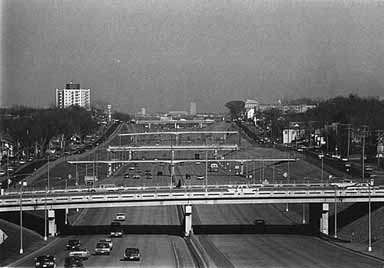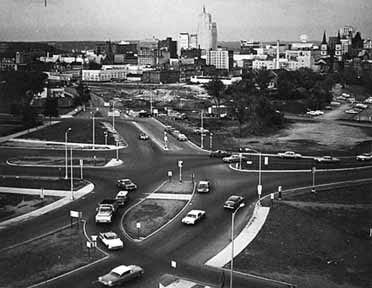Interstate 94
| Photo taken immediately after the demise of St. Paul's apartment district, 1965. I-94 is still under construction. Image Courtesy of the Minnesota Historical Society. |
President Dwight Eisenhower inadvertently created Interstate 94 by signing the Federal Aid Highway Act of 1956. Influenced by the Nazi-funded autobahn in Germany, the President and Congress initially designed the law to fund an interconnected system of roadways for military mobilization.
|
Instead, the roadways barreled through the hearts of urban centers and drastically reduced automobile commute to and from central cities. The urban renewal project effectively accelerated the suburbanization of heterosexual families and thus turned their policing eyes away from inner-city streets. In this respect, the “freeway” helped to increase vacancies, diminish property values, and initiate queer homeownership in Minneapolis and St. Paul. Homeownership, in turn, provided a basis for participating in the formation of GLBT-friendly local politics.
| Positive externalities aside, I-94 inflicted considerable damage to the area’s queer geography. St. Paul arguably suffered more—the capital city lost its downtown apartment district (see: Foxy's Bar) and the Rondo Neighborhood.
|

|
Like early-20th-century railroads leading into St. Paul Union Depot in and mid-century buses arriving at the St. Paul Greyhound Bus Depot, Interstate 94 came to symbolize entrance into the Twin Cities’ queer world in the last 30 years of the 20th century. The infrastructure is similar to its precursors in other respects as well—queer men continue to use remote rest areas for public sexual activity
This page is still under construction. -SVC
Part of Minneapolis/St. Paul, MN: 100 Queer Places in Minnesota History, (1860-1969), (1969-2010)
